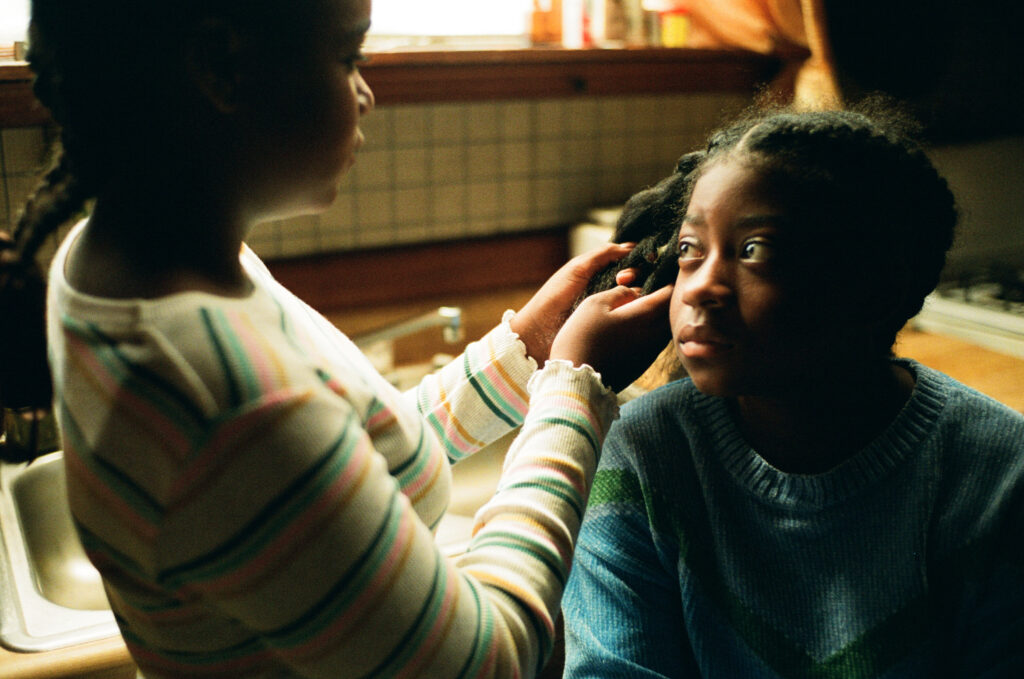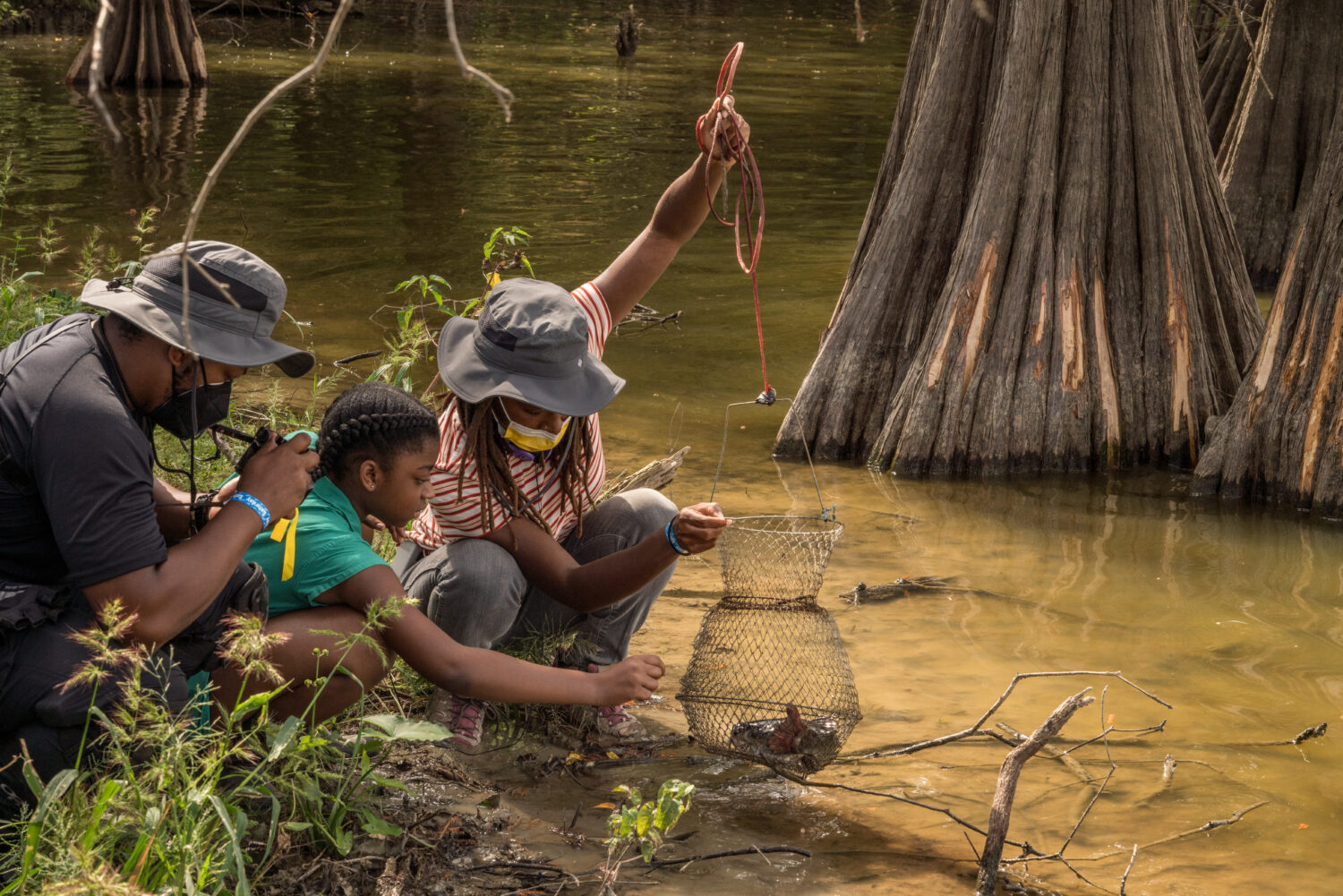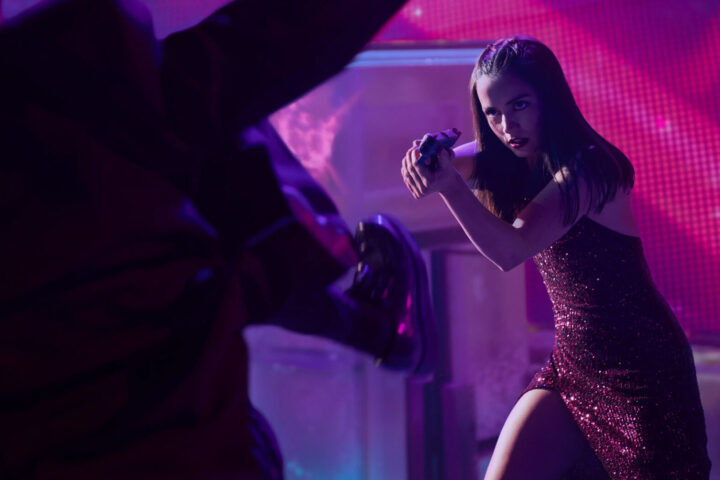In the arresting All Dirt Roads Taste of Salt, a fictional memoir rendered in non-linear structure and rooted in emotion, confident first-time feature filmmaker Raven Jackson conveys the poetic lyricism of Terrence Malick by way of the minutely observant Kelly Reichardt.
Thirty-three-year-old Tennessee native Jackson, perhaps a polymath artist—she is also an accomplished photographer and poet—finds inspiration for her quietly impactful picture in landscapes, bodies connecting through touch and a soul to its environment. In telling the story of young Mack, a rural Mississippi girl circa 1970s who evolves across decades into a woman shaped by love, loss and family, Jackson builds her picture on on frequently silent exchanges and contemplations.
I recently caught up with Raven Jackson to chat about All Dirt Roads Taste of Salt, which unfolds as a dreamlike tapestry, an immersive portrait of the American South, a glimpse into the legacies of African-American women across generations and a poignant mosaic that pieces together the fragments of a life. It is an eloquent symphony of the emotional and physical worlds, in harmonious concert, uniting nature and feeling.
Your film feels intensely personal, as if a memory piece. Did some of it spring from your childhood recollections?
Raven Jackson: Ultimately it is a fiction film, but I am pulling from some emotional truths or some details that are true.
Someone recently said it feels like a photo album of another time. Stylistically, I was reminded of both Terence Malick and Kelly Reichardt. Can you share a bit on freeing yourself from the requirements of a plot-driven narrative? You really are trusting your audience by creating a space that is not about connecting plot points.
RJ: Thank you for your kind words. I think what you said about trusting the audience is really what I am doing. I knew coming to this project that I wasn’t interested in creating a film with traditional plot points. I wanted it to be emotionally driven. I was being intentional with the character of Mack at different ages and experiences, and how they were ordered to build an emotional journey. There is a story but it is just not given in the traditional way. I wanted this to be an experience that would wash over the audience. I trusted that if the audience went with this that it would resonate.

It does because it honors a personal part of our lives, which is spent thinking and contemplating and considering. Where have we been? Where are we now at this moment? What is our relationship to our parents? Can we go back home again? What does a past relationship still mean to me? We all spend quiet time on those issues. For me, it also conveyed the feeling of growing up in a small rural town. Mine was Michigan but it doesn’t seem far away from the Mississippi of your film—fishing in rivers, riding bikes down main street and a house burning down which was a major community event. The film pungently evokes this.
RJ: Yes, thank you. I wanted the film to evoke a sense of time by feeling rather than stating a specific year. I was not interested in giving markers like ‘1970.’ I looked at a lot of my grandma’s photo albums, which were different time periods, and my mom helped me in going through and dating some of the photos to track what the years were. I was using their textures, colors, patterns and landscapes to help evoke that sense of place. Sound was very useful as well. What would Mississippi sound like? Even the quiet is loud. I wanted the quiet to have sounds that really evoked the place. And so I was using all of these different tools, from costume design to production design, being very specific and doing research to avoid explicitly indicating the time period. While the film’s log line indicates Mississippi, I’m not saying it in the film. It’s by feeling that the film is very specific, even if I’m not underlining it.
You mentioned the evocative sound design. I think anybody who has ever spent time in the country experiences a symphony of sounds—insects, frogs, the sound of the wind and a whole environment. That design was vivid in the film, suggesting a world of its own. I am sure there was significant post-production work to get all of those sound effects. It just felt very sensuous.
RJ: I love the word sensuous.
I was also intrigued by the use of the hands in the film: between Jayah Henry and Kaylee Nicole Johnson as they’re lying in the back of the truck holding hands; the grandmother whose hands are touching the children’s hands; Charlene McClure’s hands on Reginald Helms, Jr.’s back; and other times where something is passing between people.
RJ: Yes. I love and deeply trust the body’s ability to communicate without words, and the hands in particular are up there for me with the eyes. For instance, in the scene when Grandma Betty is talking to the girls about clay dirt, as written it was just hands. But in the process of making the film, there was also a discovery about just how much the hands wanted to be present in a film that does so much with what is passed down from generation to generation. I love thinking about the scene in the car with Grandma Betty and the two girls during the funeral. For me, there’s so much there in just seeing those hands on top of each other.
And also, how are these hands, as I like to say, slant rhymes? The cinematographer, Jomo Fray, and I talked a lot about this. How do the hands slant rhyme with, for example, an embrace? For instance, with Mack and Wood in the grocery story scene—is that a slant rhyme? What is happening with Isaiah and Evelyn in the dancing scene, and how does it speak to the changing relationships? Across the film, there are a lot of slant rhymes with the hands that are hopefully giving another entryway into these characters and what’s happening with their relationships and changing lives. In all those ways I felt the hands were like another portal into the film.

When you talk about the hands or the body and being able to convey things, let’s put a microscope on one scene in the movie that affected me. It’s a half hour into the film and it’s between actors Charlene and Reginald. There is a bit of dialogue at the beginning of the scene: ‘How are the kids?’ ‘They’re getting bigger.’ After that, there is an extended, non-verbal connection between them. It is very simply captured with a shot/reverse shot. But I was struck by the communication and feeling between the actors and not only when they are embracing, but the way Charlene looks at Reginald when he first enters the scene, for example. Can you share how you communicated what you wanted here to those two actors?
RJ: We intentionally shot that scene the day before the last shooting day so that they would have a sort of relationship. They are both first time actors and both are amazing. On that day I came into the trailer and they were rehearsing. I said, ‘No, we don’t need to rehearse. Let’s save it for when we’re ready.’ And I had to adjust the scene because it was first written to include a deer. I knew we were not going to get that so I adjusted it and gave them new direction. I knew that scene would linger in (their feelings) and I knew my script was just the starting point, and that when we would get to the moment where there is a hug. These are two characters that have such a long, rich history and have not seen each other for a very long time, so they are not going to hug for 15 seconds. They’re not going to hug for 30 seconds. They’re going to hug for a long time. And with Reggie, for example, we would do another take, and I would say, ‘just a little bit longer’ or ‘she smells the same.’ I would whisper these things lightly in his ear. It was things like that which would get both of them in their bodies and to be present. I like to work when there are not a lot of people around, and so it really does feel like it is just the two of them, which provides a space for them to really be in it together; just the two of them. I tried to be intentional about protecting that space for them and it was just beautiful.
I was also struck by the scene where Sheila Atim is holding the baby. In another film that might be a brief moment but here it turns into sometime very personal and epic in its own way. It takes its time. Can you share a bit about your approach to shooting that scene?
RJ: You are getting at some of my favorite scenes here! (laughter) That one was actually a pivot. It was originally scripted to happen indoors and was with the child, and looked differently. But a fridge did not get plugged in the night before so we could not shoot inside. So I had to pivot and see what was happening before me. I knew that Mylee Shannon—who plays the toddler version of Mack—was asleep, and I said, ‘Keep her asleep.’ I also knew the backyard of this home really inspired me. And I felt white would look good, so we ended up getting changing Sheila’s costume to be the white dress you see in the film, and putting a white cloth diaper on the baby while she was sleeping. And then it was just watching Sheila just walking around with this sleeping baby. There was a moment where I thought, ‘Does the scene need fog?’ And so production got some fog machines for me to see if it would work, but it did not. Elemental is a word that Jomo and I used quite a bit while talking about the visuals of the film. We just wanted it to be elemental. It didn’t need fog. We didn’t want it to be adorned. And so it was just watching Sheila care for and hold this child and just being in that moment.

You’re a photographer and a poet as well. And now you’re a filmmaker, which says to me that you’re an artist of many disciplines and there may be more to come. I think you mentioned that your photography sort of influenced this film.
RJ: Yes. I did a pitch deck for the film before I wrote a word of the script. I took photographs of family members in the south and Alabama, Mississippi and Tennessee. I also took photographs of landscapes and really just needed to feel like I was standing on the soil of the film. And I think now that this research really did inform what is in the final film. It anchored me and was a guiding light right from the beginning as to why I was driven to make this film. Whenever I would look at those photos I would think, ‘There is no way I am not making this film.’ I needed that and was very grateful to have taken them.
I understand there was something called a “daily manifesto” you created with Jomo, is that correct? What was that exactly and how did it guide what you would do on a daily basis?
RJ: Yes, it was 12 lines: remember water, remember wind, be tactile, have details, stay close, stay wide. So it was something that and both Jomo and I would read every day before production would begin, and it would ground us in what we were looking to achieve. It really put us in the feeling of what we were looking to achieve. One line was to be present to the cinema and set, and to be evocative above all else. I am grateful that we did this because every time we would read it, we were like, ‘Okay, we’re ready. Let’s go.’
Tell me about the church you used in the movie. It is instrumental in a few scenes. Was this a church you knew or was perhaps in your hometown?
RJ: It was not. Years ago and prior to having found the church, I came across a couple of Bill Ferris’s photographs of Rose Hill Church on Instagram and they stuck with me. It wasn’t just Rose Hill Church; there were some other photographs of faces as well. And while living in New York I happened to be at the Strand Bookstore looking at their photo book section, and I saw his book The South in Color, which contained photographs of Rose Hill Church, many from the late sixties and early seventies. And one photograph in particular of the church congregation really stuck with me. For the film, I needed a church location. At the time that I was still thinking we would shoot in Tennessee, but this church was in Vicksburg, Mississippi. Something was pulling me to it.
We sent them a cold email and long story short, the church was open to us scouting there and eventually shooting there. The church just has such a rich history. When I visited for the first time, I saw horses running around and could hear cows. It is just a really beautiful place and one that I feel that- I don’t know, there’s something about it. As I mentioned, I was drawn to its history, and so in the wedding scene, the song you hear—Lord I’m In Your Hand—is actually a song from when the church was in operation and performed by Mary and Amanda Gordon, pillars of the church. That song is in the trailer. And there, I also met someone who was in the photographs as a child but is now an older man. Also in the wedding scene are some congregation members who were either descendants of members of Rose Hill Church or familiar with the community. In that scene it was beautiful be able to thread different histories.
In that moment I loved how you carved that history out in faces and music. We don’t even see the altar and those who are betrothed until near the end of the scene. In closing, if I asked you to name your most formative memory from childhood, what would it be?
RJ: That’s a hard one. I don’t know if I would say that’s my most formative, but what’s coming to mind is the importance of those early mornings, including getting up to go fishing and the dirt on my hands. It is that closeness to nature and it is just everywhere in my work.
This interview has been edited for length and clarity.



